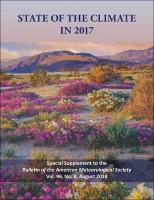Mostrar el registro sencillo del ítem
The 2017 coastal El Niño
| dc.contributor.author | Takahashi, Ken | |
| dc.contributor.author | Aliaga Nestares, Vannia | |
| dc.contributor.author | Avalos, Grinia | |
| dc.contributor.author | Bouchon, M. | |
| dc.contributor.author | Castro, Anabel | |
| dc.contributor.author | Cruzado, L. | |
| dc.contributor.author | Dewitte, Boris | |
| dc.contributor.author | Gutiérrez, B. | |
| dc.contributor.author | Lavado-Casimiro, W. | |
| dc.contributor.author | Marengo, José A. | |
| dc.contributor.author | Mosquera-Vásquez, K. | |
| dc.contributor.author | Quispe, Nelson | |
| dc.date.accessioned | 2020-02-25T22:37:31Z | |
| dc.date.available | 2020-02-25T22:37:31Z | |
| dc.date.issued | 2018-08 | |
| dc.identifier.citation | Takahashi, K, Aliaga, N., Ávalos, G., Bouchon, M., Castro, A., Cruzado, L., Dewitte, B...Quispe, N.The 2017 coastal el niño. [in “State of the Climate in 2017”]. Bull. Amer. Meteor. Soc., 99(8). S210-S242. doi:10.1175/2018BAMSStateoftheClimate.1. | en_US |
| dc.identifier.uri | https://hdl.handle.net/20.500.12542/277 | |
| dc.description.abstract | The original concept of El Niño consisted of anomalously high sea surface temperature and heavy rainfall along the arid northern coast of Peru (Carranza 1891; Carrillo 1893). The concept evolved into the El Niño–Southern Oscillation (ENSO; Bjerknes 1969), although the original El Niño and the Southern Oscillation do not necessarily have the same variability (Deser and Wallace 1987), and the strong El Niño episode in early 1925 coincided with cold-to-neutral ENSO conditions (Takahashi and Martínez 2017). To distinguish the near-coastal El Niño from the warm ENSO phase, Peru operationally defines the “coastal El Niño” based on the seasonal Niño 1+2 SST anomaly (ENFEN 2012; L’Heureux et al. 2017). While recent attention has been brought to the concept of ENSO diversity (e.g., “central Pacific” vs “eastern Pacific” events; Capotondi et al. 2015), the coastal El Niño represents another facet of ENSO that requires further study in terms of its mechanisms and predictability. A strong coastal El Niño developed off the coast of Peru from January to April 2017 (ENFEN 2017; WMO 2017a,b; Takahashi and Martínez 2017; Ramírez and Briones 2017; Garreaud 2018). The changes were dramatic within the cool coastal upwelling region, as daily SST at Puerto Chicama (7.8°S, 79.1°W) increased abruptly from ~17°C by mid-January to a peak of 26.9°C in early February (ENFEN 2017). The mean maximum/minimum air temperature anomalies along the coast ranged between +1.0°C and +2.3°C across the north, central, and southern regions during February–March. | en_US |
| dc.format | application/pdf | |
| dc.language.iso | eng | en_US |
| dc.publisher | American Meteorological Society | en_US |
| dc.relation.ispartof | urn:issn:1520-0477 | |
| dc.rights | info:eu-repo/semantics/openAccess | en_US |
| dc.rights | Atribución-NoComercial-SinDerivadas 3.0 Estados Unidos de América | * |
| dc.rights.uri | http://creativecommons.org/licenses/by-nc-nd/3.0/us/ | * |
| dc.source | Repositorio Institucional - SENAMHI | en_US |
| dc.source | Servicio Nacional de Meteorología e Hidrología del Perú | |
| dc.subject | Climatología | en_US |
| dc.subject | ENSO | en_US |
| dc.subject | Cambio Climático | |
| dc.subject | Eventos Climáticos Extremos | |
| dc.title | The 2017 coastal El Niño | en_US |
| dc.type | info:eu-repo/semantics/article | en_US |
| dc.identifier.isni | 0000 0001 0746 0446 | |
| dc.description.peerreview | Por pares | |
| dc.identifier.doi | https://doi.org/10.1175/2018BAMSStateoftheClimate.1. | |
| dc.identifier.journal | American Meteorological Society | |
| dc.source.volume | 99 | en_US |
| dc.source.issue | 8 | en_US |
| dc.subject.ocde | https://purl.org/pe-repo/ocde/ford#1.05.10 |
Ficheros en el ítem
Este ítem aparece en la(s) siguiente(s) colección(es)
-
Artículo científico [166]









